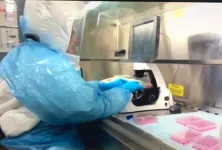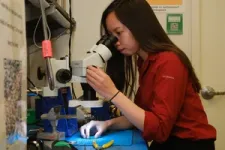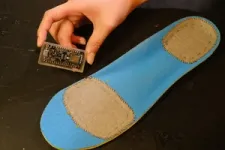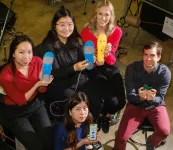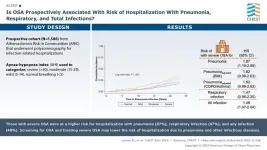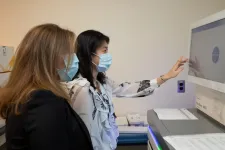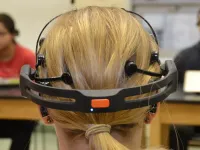(Press-News.org) UNIVERSITY PARK, Pa. — The current COVID-19 vaccines are designed to trigger an antibody response to the SARS-CoV-2 spike protein, which is vulnerable to mutations that could make the vaccine less effective over time. Focusing on the T-cell instead, Penn State researchers partnered with Evaxion Biotech on a study that was the first to demonstrate the effectiveness of an artificial intelligence-generated vaccine in a live viral challenge model. Such a vaccine may provide long-lasting immunity against future emerging variants and could be used as a model for other seasonal viral diseases like the flu.
In their study, the researchers challenged mice with a lethal dose of SARS-CoV-2 and found that 87.5% of the mice that were vaccinated with the T-cell-based vaccine survived, while only one of the control-group mice survived. Additionally, all the vaccinated mice that survived cleared the infection within 14 days post-challenge. The results were published on April 11 in Frontiers in Immunology.
“To our knowledge, this study is the first to show in vivo [in a living organism] protection against severe COVID-19 by an AI-designed T-cell vaccine,” said Girish Kirimanjeswara, associate professor of veterinary and biomedical sciences, Penn State. “Our vaccine was extremely effective at preventing severe COVID-19 in mice, and it can be easily scaled up to start testing it in humans, as well. This research also paves the way for the potential rapid design of novel T-cell vaccines against emerging and seasonal viral diseases, like influenza.”
Why do we need a T-cell-based COVID-19 vaccine when the mRNA vaccines that are already in use are so effective?
According to Kirimanjeswara, the spike protein of the SARS-CoV-2 virus is under heavy selection pressure, which can result in mutations that drive the emergence of new variants.
“This means that vaccine manufacturers will have to keep creating new vaccines that target new variants, and people have to keep getting these new vaccines,” he said.
Instead of targeting the constantly mutating spike protein, the team at Evaxion Biotech designed a vaccine that included 17 epitopes from various proteins of SARS-CoV-2 that are recognized by the immune system. These epitopes elicit an immune response from a broad selection of T cells, ensuring a sustained coverage of future variants.
“The virus would have to undergo too many mutations to be able to escape this T-cell-mediated immunity, so that is one advantage,” said Kirimanjeswara. “The second advantage is that T-cell-mediated immunity is usually long lasting, so you don’t need repeated booster doses.”
If T cells are so great at remembering foreign agents, why were the first-generation COVID-19 vaccines designed to elicit responses from antibodies?
“It's harder and takes longer to produce a T-cell-based vaccine than an antibody-based one,” said Kirimanjeswara. “Given the urgency with which we needed a vaccine to address the COVID-19 pandemic, it makes sense that vaccine manufacturers created an antibody-based vaccine. Now that the urgency has passed, a second-generation T-cell-based vaccine could be more effective and last longer.”
According to co-author Anders Bundgaard Sørensen, project director, Evaxion Biotech, other biotechnology companies are developing T-cell-based vaccines, but this team’s vaccine uses multiple types of artificial intelligence in a platform called RAVEN (Rapidly Adaptive Viral rEspoNse) to predict ideal targets for vaccines.
“RAVEN is really adaptable,” Sørensen said. “We don't have to wait for a new strain of a virus to arrive to develop a vaccine. Instead, we can predict what will be needed in advance. That's not something that others are doing right now.”
Sørensen noted, “It's much easier to get broad coverage with a T-cell vaccine, as we can include multiple epitopes targeting different proteins.”
He added that, in addition to producing better COVID-19 vaccines, the RAVEN platform could be used to develop better influenza vaccines.
“Oftentimes, the influenza vaccines that are designed work only 30-40% of the time, so a lot of people end up getting sick,” he said. “As the world becomes increasingly integrated, that problem will become larger and larger. Our platform uses AI to better predict what will be needed.”
Sørensen noted that Evaxion benefitted from partnering with Kirimanjeswara and his Penn State colleagues because of their deep expertise in animal models of infectious disease and because the university houses a BSL-3 laboratory in which they could safely study the SARS-CoV-2 virus.
He said, “Our results are a testament to the power of industry-university partnerships.”
Other Penn State authors on the paper include Katherine Restori, assistant research professor; McKayla Nicol, graduate student; and Bhuvana Katkere, assistant teaching professor. Other Evaxion Biotech authors on the paper include Gry Persson, project manager; Julie Hinchelli Emdrup, research associate; Sophie Schussek, competence manager; Michael Schantz Klausen, senior associate; and Birgitte Rønø, chief scientific officer.
Innovation Fund Denmark supported this research. The Huck Institutes of Life Sciences and the College of Agricultural Sciences provided support for studies performed at Penn State.
The Eva J. Pell Laboratory is an ABSL3 (animal biological safety level three) laboratory located on Penn State’s campus. It is a self-contained, standalone facility, which means that all materials, including waste products, are managed on site for increased safety. The lab is inspected by the National Institutes of Health and Centers for Disease Control and Prevention and is approved to conduct research on infectious agents.
END
T-cell vaccine for COVID-19 may last longer than current vaccines
Artificial intelligence platform quickly designs T-cell-based vaccines that provide broad coverage; may be used to develop seasonal flu and other vaccines
2023-04-13
ELSE PRESS RELEASES FROM THIS DATE:
Rice U. students engineer socks for on-the-go neuropathy treatment
2023-04-13
HOUSTON – (April 13, 2023) – Need a little spring — or buzz — in your step? A wearable electrical-stimulation and vibration-therapy system designed by Rice University engineering students might be just what the doctor ordered for people experiencing foot pain and balance loss due to diabetic neuropathy.
Rice engineering students in the StimuSock team — Abby Dowse, Yannie Guo, Andrei Mitrofan, Sarah Park and Kelly Xu — designed a sock with a smart insole that can deliver both transcutaneous electrical nerve stimulation (TENS) and vibration therapy that block pain signals to the brain and ...
UC Davis study finds tweets can amplify, disrupt, unite and divide
2023-04-13
Social media connects people and amplifies different aspects of humanity in good and bad ways. But the effects of social media appear neither universally good nor bad, but rather present an oscillating, dynamic system that can be divisive but also uniting, a new University of California, Davis, study suggests.
Department of Communication researchers said their findings both in an observational study and simulation speak to the ongoing debate about social media’s contributions to political polarization, misinformation and echo chambers. To conduct their research, ...
Highlights from the journal CHEST®, April 2023
2023-04-13
Glenview, Illinois – Published monthly, the journal CHEST® features peer-reviewed, cutting-edge original research in chest medicine: Pulmonary, critical care and sleep medicine and related disciplines. Journal topics include asthma, chest infections, COPD, critical care, diffuse lung disease, education and clinical practice, pulmonary vascular disease, sleep, thoracic oncology and the humanities.
The April issue of the CHEST journal contains 50 articles, including clinically relevant research, reviews, case series, commentary and more. ...
First-in-Canada clinical RNA sequencing platform may improve rare disease diagnostics in pediatrics
2023-04-13
A new clinical RNA sequencing platform at The Hospital for Sick Children (SickKids) is helping to facilitate research into rare genetic conditions and carve a path for Precision Child Health, a movement at SickKids to deliver individualized care for every patient.
RNA sequencing provides a different way of looking at the genes, by looking at how the body interprets the genetic code rather than looking directly at the genetic code itself. While DNA-based tests like genome sequencing take a picture of a person’s genetic code, scientists can better understand how the DNA is being read by also looking at RNA, which carries instructions for making ...
Durability of bivalent boosters against Omicron subvariants
2023-04-13
(CHAPEL HILL, N.C., April 13, 2023) New research led by the UNC Gillings School of Global Public Health shows that bivalent COVID-19 boosters are still providing effective protection from hospitalization and death, even against the most recent omicron subvariants.
Published this week in the New England Journal of Medicine (NEJM), researchers found that the bivalent boosters were 67% effective in preventing hospitalization and death in those who had been previously vaccinated or boosted. Effectiveness waned to 48% after four weeks, 44% after 10 weeks and 38% after 20 weeks.
Though ...
Improving the accuracy of near-infrared fluorescence in cardiovascular imaging
2023-04-13
Cardiovascular diseases (CVDs) or heart diseases are still the leading cause of death globally. Fortunately, doctors are now equipped with more advanced and sophisticated tools that help them diagnose CVDs. A prominent example is intravascular ultrasound (IVUS), which enables cardiologists to obtain images of the inside of blood vessels using a thin ultrasound probe. These images can then be used to assess problems such as the thickening of arteries caused by fat or plaque buildup.
While IVUS is undoubtedly a powerful ...
New tool to study hepatitis B could open the door to a cure
2023-04-13
Hepatitis C and hepatitis B viruses both attack the liver, eventually causing deadly cirrhosis or cancer. But while antivirals can cure 95 percent of HCV infections, its cousin HBV has long eluded effective therapeutics. As a result, nearly 1 million people die from HBV every year.
Now researchers from the lab of Rockefeller’s Charles M. Rice—who shared the 2020 Nobel Prize in Physiology or Medicine for pioneering novel methods to grow and study HCV—have developed an approach for studying HBV in the lab that ...
Biological bouncers: How immune cells yank antigens from surfaces to learn and evolve
2023-04-13
Most cells evolve slowly, accumulating incremental changes that better suit their environments. Immune cells, because they must adapt rapidly to counter new threats, evolve much more quickly. Part of that, UCLA physicists now report, rests on their ability to forcibly pull antigens off other cells’ surfaces and “study” them.
By using this type of mechanical force, the immune system’s B cells, which create antibodies that fight off harmful pathogens like viruses, bacteria and parasites by targeting their ...
OHSU researchers assemble comprehensive atlas of gene mutations in human tissue
2023-04-13
Researchers have created the largest atlas of post-zygotic genome mutations in healthy human tissue ever assembled — a scientific advancement that could unlock new avenues for diagnosing and treating genetic disease. It is the largest ever in terms of the combined number of tissues and number of donors sampled.
The study, led by researchers at Oregon Health & Science University, published today in the journal Science.
The development points the way toward understanding the genetic underpinnings of disease associated with cancer as well as innumerable conditions caused by cellular malfunction, including ...
In sync brainwaves predict learning, study shows
2023-04-13
Students whose brainwaves are more in sync with their classmates and teacher are likely to learn better than those lacking this “brain-to-brain synchrony,” shows a new study by a team of psychology and education researchers. The findings, which appear in the journal Psychological Science, offer new insights into the learning process.
“This is the first study to show that the extent to which students’ and teachers’ brainwaves are in sync during real-world learning can predict how well students retain information from class,” says lead author Ido Davidesco, an assistant professor at the ...
LAST 30 PRESS RELEASES:
Sleeping in on weekends may help boost teens’ mental health
Study: Teens use cellphones for an hour a day at school
After more than two years of war, Palestinian children are hungry, denied education and “like the living dead”
The untold story of life with Prader-Willi syndrome - according to the siblings who live it
How the parasite that ‘gave up sex’ found more hosts – and why its victory won’t last
When is it time to jump? The boiling frog problem of AI use in physics education
Twitter data reveals partisan divide in understanding why pollen season's getting worse
AI is quick but risky for updating old software
Revolutionizing biosecurity: new multi-omics framework to transform invasive species management
From ancient herb to modern medicine: new review unveils the multi-targeted healing potential of Borago officinalis
Building a global scientific community: Biological Diversity Journal announces dual recruitment of Editorial Board and Youth Editorial Board members
Microbes that break down antibiotics help protect ecosystems under drug pollution
Smart biochar that remembers pollutants offers a new way to clean water and recycle biomass
Rice genes matter more than domestication in shaping plant microbiomes
Ticking time bomb: Some farmers report as many as 70 tick encounters over a 6-month period
Turning garden and crop waste into plastics
Scientists discover ‘platypus galaxies’ in the early universe
Seeing thyroid cancer in a new light: when AI meets label-free imaging in the operating room
Neutrophil-to-lymphocyte ratio may aid risk stratification in depressive disorder
2026 Seismological Society of America Annual Meeting
AI-powered ECG analysis offers promising path for early detection of chronic obstructive pulmonary disease, says Mount Sinai researchers
GIMM uncovers flaws in lab-grown heart cells and paves the way for improved treatments
Cracking the evolutionary code of sleep
Medications could help the aging brain cope with surgery, memory impairment
Back pain linked to worse sleep years later in men over 65, according to study
CDC urges ‘shared decision-making’ on some childhood vaccines; many unclear about what that means
New research finds that an ‘equal treatment’ approach to economic opportunity advertising can backfire
Researchers create shape-shifting, self-navigating microparticles
Science army mobilizes to map US soil microbiome
Researchers develop new tools to turn grain crops into biosensors
[Press-News.org] T-cell vaccine for COVID-19 may last longer than current vaccinesArtificial intelligence platform quickly designs T-cell-based vaccines that provide broad coverage; may be used to develop seasonal flu and other vaccines
